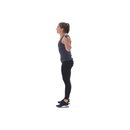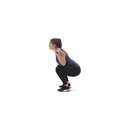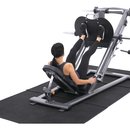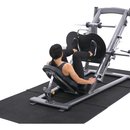Shoulders | Back | Arms | Chest | Legs | Abs & Calves | Final
In today's world, you'd be hard pressed to find a body part more challenging for a woman to develop and shape than the legs. Women are constantly seeking advice on how to build the muscles, downsize the legs, shape the glutes, etc. The truth is, the legs are not that challenging to build if you're educated and motivated.
If a nice pair of gams isn't the ultimate sign of a fitness fanatic, I'm not sure what is! A tight pair of glutes, a sweeping set of thighs, and firm, full hamstrings are the ultimate display of feminine strength and beauty. In this article, I plan to leave no stone unturned as I delve into the details of fine-tuning your leg training program so that you can also get those glorious gams you've always dreamed of!
The legs are one of the largest and most complicated parts of the whole body. They can best be broken down into two major groups—the quadriceps and the hamstrings. While not considered a part of the legs, no leg article would be complete without covering the glutes! So, I've added the glutes in to this article as well.
The Quadriceps
The first of these, also known as the "quads," is comprised of four (hence the term quad) separate muscles. The rectus femoris is the most prominent and is located in the front middle of the thigh. The vastus lateralis is located on the outer thigh.
Both of these muscles run almost the entire vertical length of the front thighs. The vastus medialis is the teardrop-shaped muscle just above the knee and runs about a third of the length of the thigh. The last of the four, which is not visible, is the vastus intermedius. The muscles of the quadriceps are designed to extend the knee joint and flex the hip joint.
The Hamstrings
The leg biceps, often called hamstrings, are also comprised of four muscles. They include two large muscles—the biceps femoris (long head) and the semitendinosus—which run most of the length of the rear thighs, and the much smaller semimembranosus (underlying the semitendinosus) and the short head of the biceps femoris, which runs along the outer rear thigh and under the long head of the same muscle group.
The hamstrings are responsible for flexing and rotating the knee joint and extending the hip joint.
The Glutes
There are three parts to the gluteal's—maximus, medius, and minimus. The maximus is the largest of the three and covers the main part of the rear. The medius is located on the upper and outer portion of the rear, while the minimus is a smaller muscle that mostly lies under the maximus.
The glutes are primarily responsible for extending the hips, but are also used to externally rotate, abduct, and adduct the hips.
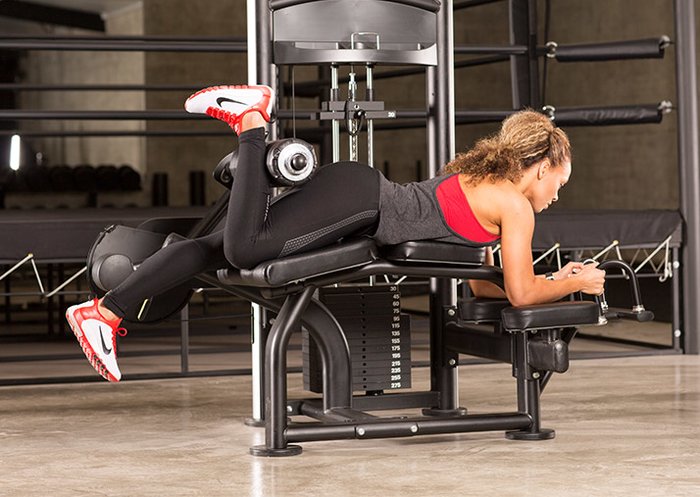
Training Basics
Lucky for us women, we are stronger in the legs than in any other body part. In fact, we're actually stronger in the legs than men are, in relation to the rest of our bodies. So women have no excuse for lagging legs!
Compound Movements
- Squat—variation: Smith Machine, Unilateral—Foot Stance: Close, Normal, Wide-Foot Placement: Forward, Toes Out
- Machine Hack Squat
- Variation: Olympic Bar, Smith Machine, Unilateral Foot Stance: Close, Normal, Wide - Foot Placement: Forward, Toes Out
- Leg Press—variation: Horizontal, Vertical, 45 Degrees, Unilateral Foot Stance: Close, Normal, Wide - Foot Placement: Forward, Toes Out
- Lunges—equipment: Dumbbell, Smith Machine, Barbell Variation: Reverse, Walking, Side, 45 Degree
- Front Squat Variation: Smith Machine
Isolation Movements
Quadriceps
- Leg Extension
- Sissy Squat variation: Weighted
Hamstrings
- Stiff Legged Dead Lift variation: Romanian. Grip Placement: Pronated, Neutral
- Leg Curl variation: Lying (Prone), Seated, Standing. Equipment: Cables, Free Motion
- Hip Abduction variation: Standing, Seated. Equipment: Cable, Free Motion, Machine
- Hip Adduction variation: Standing, Seated. Equipment: Cable, Free Motion, Machine
- Good Morning
Glutes
- Kneeling Hip Extension
- Reverse Hyper Extension
- Standing Hip Extension
Synergistic Movements
By incorporating these exercises into your other workouts, you can get additional stimulation from the muscles of the legs.
- Traditional Deadlifts (Back)
- Clean and Press (Shoulders)
You can also work your legs in most cardiovascular activities. Some of the best include sprinting, bleacher/stair running, and cycling.
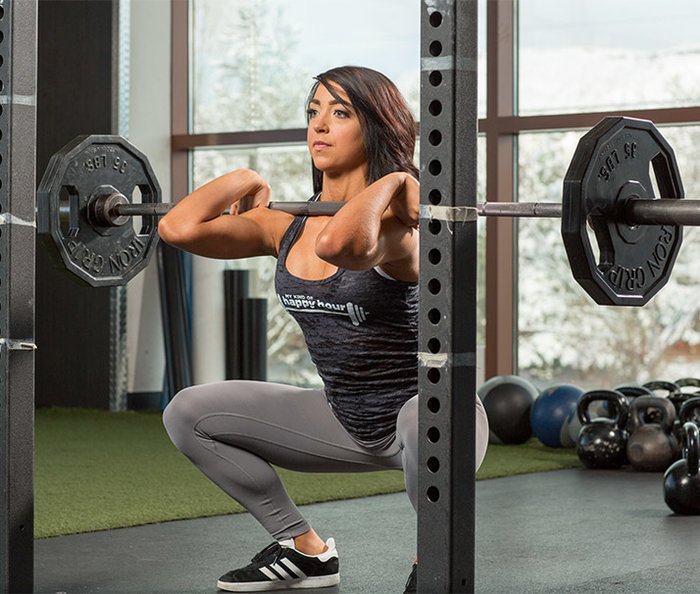
Developing Your Training Program
Compound movements are great because they work all three of the leg groups. By flexing the hips and extending the knees in one movement, you're able to lift a lot more weight and you also save yourself time in the gym. Multi-joint exercises also burn more calories, require more intensity, and are much more effective than isolation movements. Make compound movements the staple of your leg workouts, and supplement them with isolation movements to help shape the muscles.
Choose 2-3 compound movements and 2 isolation movements - one each for hamstrings and quadriceps - to ensure you are targeting all the muscles of the legs with enough resistance and intensity to stimulate new growth in size and strength.
Sets and Repetitions
The muscles of the legs respond better to a slightly higher rep scheme. I recommend training your hardest sets in the 8-12 range and performing 3-4 working sets on top of 2-3 warm-up sets. Start with a 20-25 rep range and pyramid up in weights as you lower the number of reps per set.
Of course, everyone knows that change is good, so there's nothing wrong with throwing in some crazy high sets in the 50 rep range! More power to ya if that's your thing! In the same sense, it's not bad to go down to a low of 2-4 reps on your heaviest sets of squats. Nothing builds strength and power better than this!
Additional Muscles Often Trained With Legs
A lot of trainees like to add calves to their leg workout. I do this myself. This is great if neither legs nor calves are a weak body part for you. If they are, you may wish to train calves on another day, say, with shoulders, or to train them twice a week.
Frequency, Duration and Intensity
If legs aren't a weak body part, you only need to train them once a week. If they are a weak body part, you still shouldn't train them more than once a week. Why is this? Well, the legs are such a huge body part that they take a very long time to recover from a heavy, intense training session. If you are hitting them with ultimate intensity twice a week, you'll be over-training them. If you feel like your legs are rested up after two or three days and you can train them twice a week, you're not training with enough intensity!
Some people split their leg workouts in two by training quads one day and hams another. This is great in concept, but the fact is you cannot isolate one of these muscles through compound movements without largely involving the other. If you follow this type of program, you are essentially training your entire leg muscles twice a week.
There are certain ways of performing an exercise to stress one muscle group over the other. This is a great idea if one of the leg muscles is a weakness for you; however, you may be hurting yourself more than you're helping yourself as you risk over-training this way.
There is an instance where I would recommend training legs twice per week. If you've already reached the amount of development you want, or if your legs are more muscular and larger in proportion to your upper body, it would be wise to train them twice a week at a high intensity but with a higher rep scheme and lighter weights, more like a circuit-style training program.
As for intensity, if you've read any of my previous "No Fluff" articles, you'll know I'm a stickler for it. In fact, that's putting it lightly. If you're not training with intensity, if you're not leaving the gym floor like a granny without her walker, you haven't trained hard enough! And, if you're not training intensely enough, you don't want it bad enough.
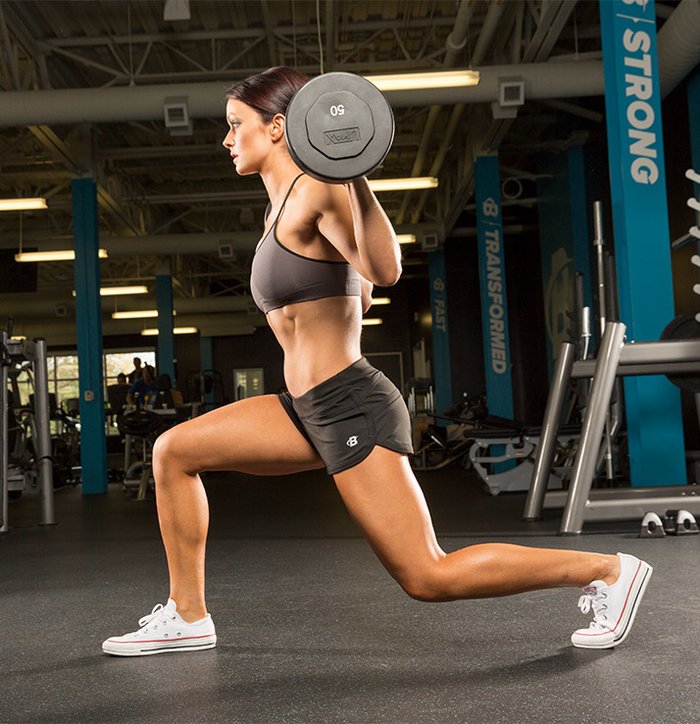
Targeting Specific Goals
That Dreaded "T" Word—Tone!
Yes, I had to put this in here. So many women use this word and frankly, I can't stand it! There are two main goals in fitness - adding muscle mass and losing body fat. You either want to do one or the other, or both. You can't "tone" a body part. So decide what your problem area or areas are and focus your workouts around them.
If you have "big" legs - and when I say big I mean larger in proportion to your upper body - first determine whether the size comes from fat or muscle. It shouldn't be hard to tell. If the size is muscle, you should have a nice outside sweep to the thighs, the lower portion of the teardrop should be visible, and there shouldn't be much jiggling or cellulite on your legs.
Your hamstrings should be round and full. In other words, your legs might be big, but they should still be curvy and very tight. If the size is fat, you won't have much shape to the legs and they will be loose and jiggly.
On that note, let me add that it is a rare woman indeed that has zero cellulite on her glutes and the back of her legs! I even have it until I reach around 11% body fat. How many average women do you know that maintain such a low body fat year-round? The list would be slim to none. Try to look past this when determining your weak body parts. Look at muscular development rather than fat stores.
If and only if you determine your legs are too muscular, then you shouldn't lift heavy weights for legs. Everyone else - and this will be the majority - should continue lifting as heavy as they absolutely can until they reach their goals for size and development.
Adding Mass Safely
If your goal is to add size to your legs, you must, must and - did I say must? - do free weight squats! No, not squats on the smith machine. No, not leg presses. You need to do heavy, in the cage, Olympic bar squats. Be sure to get your form down, first and foremost. Practice with only the bar, or on the smith machine, until your form is so much a habit you can do it with your eyes closed. And if you're still reluctant to squat, you don't have to take my word for it. Read this poem for some motivation!
SQUATTIN'
Down the road, in a gym far away a young man was heard to say, "No matter what I do, my legs won't grow!" He tried leg extensions, leg curls, leg presses too. Trying to cheat, these sissy workouts he'd do! From the corner of the gym where the big guys train Through a cloud of chalk and the midst of pain, Where the big iron rides high, and threatens lives, Where the noise is made with big forty-fives, A deep voice bellowed as he wrapped his knees, A very big man with legs like trees, Laughing as he snatched another plate from the stack, Chalked his hands and monstrous back, Said, "Boy, stop lying and don't say you've forgotten! Trouble with you is you ain't been SQUATTIN'!"
Squat heavy every other week and supplement squatting on your off weeks with additional compound movements such as leg presses, lunges, and hack squats.
Again I will stress, make sure your form is perfect. Begin the exercise with your feet slightly wider than shoulder width apart, chest out, shoulders back, abs and low back tight, and knees slightly bent.
Descend into the movement with a strong straight back by pushing your glutes out behind you as if sitting in a chair. Keep your chest up throughout the movement, and pause at the bottom once you've reached a thighs parallel (or slightly lower) position.
Explode upward in a strong, smooth movement. Keep in mind that you want to go heavy, but you don't want to compromise form, or you're only cheating yourself. Only go up in weight once your form is perfect on the heaviest of sets.
Training At Home
If you want to train at home, get yourself a squat rack! Seriously, without an Olympic bar and rack, there isn't much you can do with heavy poundage at home. You can lunge and squat your heart out with little to no resistance, and likewise you'll see little to no results.
OK, I'm not really giving many options here. There are some things you can do at home for legs, but you at least need heavy dumbbells and lifting straps if you have a weak grip. With those items you can do heavy lunges, dead lifts, and plie squats.
Exercise Variety
Keeping your leg workouts varied is not difficult at all. There are so many compound movements and different variations for isolation movements. Keep the order and choice of your compound movements different for every workout. This ensures you are adequately hitting the muscles from all angles with different amounts of stress at different times.
Symmetry
Good leg symmetry is vital in physique competition, and is still quite important to the non-competitor. You should have firm, round glutes, a nice wide sweep of the quad tapering out and back in at the knee, with the calves tapering slightly out and back in at the ankles. From the side, your quad and hamstring development should be equal and both should be full and round.
In relation to the upper body, the shoulders should be much wider than the hips, and the flare of the lats should be repeated in the flare of the quads.
For overall leg development, choose a shoulder-width stance with toes slightly turned out. To emphasize the outer quads, place feet close together with toes pointing forward. Finally, to hit the inner thighs, opt for a wider stance with toes turned out at a wide angle.
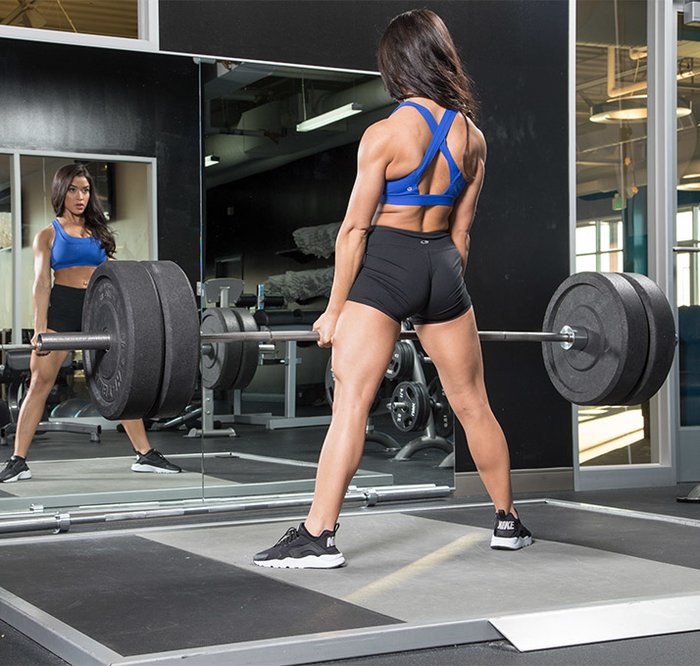
Isolation
If you wish to isolate one leg muscle over the other, you can do so with certain foot and weight placements. For overall quad development, you want to stick with a close-stance foot placement with toes pointing slightly outward. Concentrate on feeling the quads doing the work throughout the movement, and really squeeze them at the top of the movement. You can even place a weight plate under your heels when doing these exercises to better stress the quads.
Just be sure to keep strict form and make sure your knees don't travel past your toes as this puts undue strain on the knee joints. To place more emphasis on the hamstrings during compound movements, concentrate on driving the weight up through the heels. Visualize the hams doing the work and give them a big squeeze at peak contraction.
You can also affect how much stress is put on the desired muscle during isolation movements. To stimulate the quads during leg extensions, be sure to fully extend your knees at the height of the movement. You can even hold the peak contraction for as long as you can. This is a great isolation movement that gives you an unbelievable burn! For overall development, be sure to keep the toes pointing forward with the tops of the feet facing the ceiling. To emphasize the inner thighs, turn the toes and tops of the feet slightly outward.
To stress the hams during leg curls, keep strict form and prevent the hips from rising off the bench to assist in the lift. Standing leg curls are great because they force you to keep your hips in place, putting more emphasis on the hams.
Prioritization
If legs are a weak body part for you, train them on day one of your training split so that you can hit them with renewed motivation and a higher level of energy. Focus on making every rep count - perfect form, challenging poundage, feeling the movement, squeezing the muscles, and training with killer intensity - to guarantee you'll be getting the most out of your training sessions.
I highly recommend alternating your workouts every other week between the power building exercises (squats, dead lifts) in the low rep range, and traditional compound and isolation movements in a higher rep range. This gives you the best of both worlds - stimulation for ultimate power and strength from one workout, and high-intensity movements for size and shape in another.
Go Heavy, Go Hard...
You know I can't write this article without stressing yet again how important it is to train heavy. While most advanced female trainees know the importance of this already, many of them reach a plateau where they can't lift any heavier no matter how hard they try.
Well, I'm here to tell you that there's a way around this! If you are in fact following my recommendation for the power building workouts every other week, you'll also be following my sample training programs that involve 6 or more sets per body part. If you're doing this, going up in poundage is almost guaranteed every other week. The key to this is the large number of sets at increasingly heavy weights.
Take squats for instance. The first 3 sets are more than just warm-ups; they allow you to go really deep in your squats and get an unreal range of motion because the weight is so much lighter than in your really heavy sets. As you increase weight and lower reps, you'll notice your range of motion shortening (this is only natural, but make sure you still always go to parallel).
Then, as always, you'll reach your final set and if you try to increase weight, you'll only get out half the reps you were aiming for! It can get very frustrating, but this is in fact what you want to do. While you shouldn't sacrifice weight for form, it's just as important not to lift a lower weight to "make" your set number of repetitions. Who cares if you make all six reps if you're lifting at the same weight you used for the last 3 weeks?! It's much better to have gone up 10 or 15 pounds and fallen short 2 reps.
This new stimulation will prime your muscles for growth, then you'll have two full weeks to rest. By the next time you hit the squat rack, you should be able to knock out 2-4 more reps at that heavier weight than you previously had. Try it, and I guarantee you'll love it!
Sample Leg Training Program
If you choose to train calves with this workout, simply add 5-6 sets of two different calf exercises at the end of your workout. In addition, you may wish to train calves on another training day.

BodyFit
$6.99/month- 2,500+ expert-created single workouts
- 3,500+ how-to exercise videos
- Detailed workout instruction
- Step-by-step workout tips
- Training at gym or at home
- Access to Workout Plans
- Access to Bodyfit App
- Store Discounts
Already have a Bodybuilding.com account with BodyFit? Sign In

What comes with BodyFit?

- Instructional Videos
Don't risk doing a workout improperly! Avoid injury and keep your form in check with in-depth instructional videos.

- How-to Images
View our enormous library of workout photos and see exactly how each exercise should be done before you give it a shot.

- Step-by-Step Instructions
Quickly read through our step-by-step directions to ensure you're doing each workout correctly the first time, every time.

BodyFit
$6.99/month- 2,500+ expert-created single workouts
- 3,500+ how-to exercise videos
- Detailed workout instruction
- Step-by-step workout tips
- Training at gym or at home
- Access to Workout Plans
- Access to Bodyfit App
- Store Discounts
Already have a Bodybuilding.com account with BodyFit? Sign In

What comes with BodyFit?

- Instructional Videos
Don't risk doing a workout improperly! Avoid injury and keep your form in check with in-depth instructional videos.

- How-to Images
View our enormous library of workout photos and see exactly how each exercise should be done before you give it a shot.

- Step-by-Step Instructions
Quickly read through our step-by-step directions to ensure you're doing each workout correctly the first time, every time.
Pyramid up in weight on every set. Each set should become increasingly difficult, and ultimate failure should be reached on the final two sets. Rest time between sets should be 1 - 1 ½ minutes.



